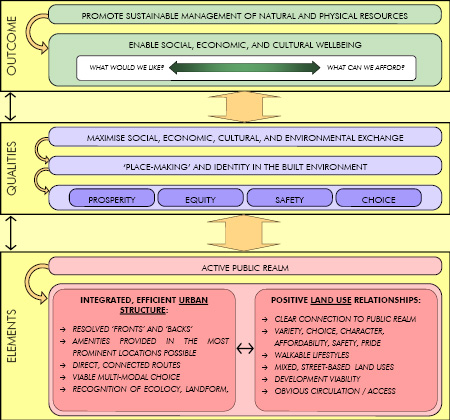Sustainable management in Rodney
Rodney District Development Design Guide

Relationship Between the Built Environment and Community Well-Being Rodney District Development Design Guide (second draft), Rodney District Council
What is social, economic, and cultural well-being?
The Resource Management Act definition of sustainable management (section 5) focuses on social, economic, and cultural well-being.
This is a very broad outcome and people with different viewpoints will have different ideas about when it is being enabled.
A further difficulty is that sometimes well-being is best served by a less than ideal outcome than no outcome at all—for many reasons the ‘best’ development is not always deliverable.
Place-making influences well-being
Well-being and quality of life is inextricably linked to the ability of people to engage in social, economic, cultural, and environmental exchange. As all exchange occurs at some point in space the built environment can play a large role in either facilitating or lessening potential exchange.
People will not willingly engage in exchange in a space they do not feel comfortable in. Well-being will accordingly not be maximised in Rodney unless our settlements are thriving, individual, and distinct places within which people and activities can clearly identify themselves.
The public realm is critical
The public realm (parks, roads, squares, beaches, and public-use buildings) is the main setting for exchange or all sorts.
To maximise exchange the public realm needs to be as convenient, comfortable, and safe as possible. The way in which private activities relate to it is just as critical to these as the design quality of the public realm itself.
A guide to the guideline
- Urban design as a way to balance all interests
- Sustainable management in Rodney [This page]
- Issues that affect all development types
- Site analysis and response
- Subdivision and urban structure: pages 7–8
- Transport and movement
- Issues that affect specific development types
- Residential
- Coastal development
- Town centres
- General employment land
- Case study examples—before and after
- Peripheral residential
- Typical residential
- Mixed density urban residential
- Shopping centre
- Large-format retail
- Office park
- Committing to quality
- A appendix—implications for resource consents
Further reading
There is a wealth of information available on detailed design elements. Instead of repeating them, this guide will focus on the primary ones relevant in Rodney. Sources of further information will be referenced where relevant throughout but in an overall sense the following are key sources:
- People+Places+Spaces: A Design Guide for Urban New Zealand; Ministry for the Environment, 2002
- New Zealand Urban Design Protocol; Ministry for the Environment, 2006
- Associated Urban Design Protocol documents; Ministry for the Environment, 2006–today
- National Guidelines for Crime Prevention Through Environmental Design in New Zealand; Ministry of Justice, 2006.
